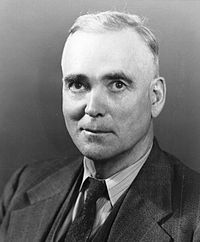Dr. R.G. Ferguson
| Dr. R.G. Ferguson | |
|---|---|
 |
|
| Born |
12 September 1883 Joliette, North Dakota |
| Died | 1964 (aged 80–81) |
Robert George Ferguson, O.B.E., B.A., M.D., LL.D., (12 September 1883 – 1964) was a pioneer in North America's fight against tuberculosis (TB) and the introduction of free treatment.
As Medical Director, and later as General Superintendent of the Saskatchewan Anti-Tuberculosis League Canada, he achieved many firsts for the province, including
Furthermore, Dr. Ferguson was a pioneer in long-term BCG vaccine research, quite controversial at the time.
He was born 12 September 1883 on a farm near Joliette, North Dakota, where his parents had moved from Ontario. In 1903 the family moved to a homestead near Yorkton, Saskatchewan. "George's" education was interrupted following public school by a spell of homesteading on his own before starting high school in Winnipeg at the age of 20. At first he planned a career in the Church, and attended Wesley College (Manitoba), carrying out mission field work in Alberta in 1908 and 1912. After earning a Bachelor of Arts degree, a Bronze Medal in Arts and being selected Senior Stick by classmates, his path changed and in 1916 he graduated in medicine, earning another Bronze Medal. In his final year of medical school he worked part-time in a laboratory making typhoid vaccine for the Canadian Expeditionary Force. Dr. Ferguson's post-graduate work included training at the London Hospital in England, and at Harvard School of Medicine, Harvard University.
Ferguson married the former Helen Ross of Wynyard, Saskatchewan in 1916.
A detailed description of Ferguson's early year achievements and family can be found at http://fergusonfamilygenealogy.wordpress.com/r-george-ferguson-1883-1964/ [1]
Following his graduation Dr. Ferguson was appointed Assistant Medical Superintendent, Acute Infection Hospital, Winnipeg. From here he went to the Fort Qu'Appelle Sanatorium intending to stay for six months. He remained for 31 years. He was a skilled administrator with a knowledge of economics and the ability to analyze the dire challenge presented by rampant TB infection in the community. Native populations were particularly susceptible. In 1917 the Province of Saskatchewan had the nation's highest incidence of tuberculosis with a rate of 50 cases per 100,000 population. Dr. Ferguson saw quickly that the only way to deal with this situation was to provide diagnosis, treatment and hospitalization at no cost to the patient. This was a huge political challenge. Dr. Ferguson persisted in his efforts, working patiently to gain support from TB sufferers, the public, members of the medical profession, and, last but not least, politicians. As one of three members appointed by the Provincial Government to form the Saskatchewan Anti-Tuberculosis Commission in 1921 he wrote the entire report. Nineteen of its 22 recommendations were implemented. Chief among them was making the cost of diagnosis and treatment of TB a public responsibility. Upon Ferguson`s death in 1964 then Saskatchewan Minister of Health Minister Allan Blakeney said, "The introduction of diagnosis and treatment of tuberculosis at public expense was one of the early and essential steps in developing a program of health services for all."
...
Wikipedia
